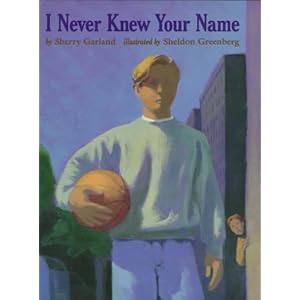Tuesday, July 3, 2012
I Never Knew Your Name, by Sherry Garland
I Never Knew Your Name
by Sherry Garland
illustrated by Sheldon Greenberg
©1994
New York: Ticknor & Fields
ISBN 9780395696860
Annotation
A 10- or 12-year-old boy speaks to a teenage neighbor, relating what he's witnessed of the teen's life and how he wished they could have been friends... if only the teen hadn't committed suicide.
Commentary
The simple text is given entirely from the younger boy's perspective; the reader infers several key points about the teenager's life: he is good at basketball, but never chosen for the pickup games; he spends time alone; he is shy around girls; other kids pick on him; he is kind to animals; his parents aren't involved in his life. It's a touching portrait of a loner with a good heart, perhaps misunderstood and neglected. No one really sees him or understands him, and even the young narrator has a limited perspective gained from repeated short observances. The illustrations are somewhat blurred, which could indicate imperfect memory, or tears, or just the limitations of a child's understanding. Light and dark pages show the passing of time, and emotions are heightened by the shadows over the characters' faces.
Plenty of people would think the topic of suicide is inappropriate for children. I can see informal challenges being made if this picturebook were found in a middle school library, even though no graphic detail about the method of suicide is included. Suicide is, in fact, one of the "social issues" that is so frequently a point of conflict that it's an option on an ALA survey about banned/challenged books. However, with the rate of youth suicide at the high levels that have been publicized through the Trevor Project and the It Gets Better campaign, this is a subject that should and must be discussed. I believe that this book would be appropriate both for teenagers and for those who are the age of the narrator, because the story points out that suicide affects many people, not just one. Also, it shows that a single perspective never tells the whole story. In this situation, teens who have snubbed the unnamed young man are perplexed when he takes his own life, and a little boy who never even spoke to him is sad to have missed the opportunity to make friends.
To support the book in the face of a formal challenge, it would be crucial to have a strong understanding of the library's official policies on censorship and collection development. Thankfully(?), I have quite a lot of experience with irate feedback from my years of customer service. Some tactics that would be particularly helpful would be:
-letting the patron "vent"
-isolating the specific points of the complaint or challenge
-mirroring the complaint: "I hear you saying...", "As I understand your concern...", "Let me see if I'm understanding correctly..."
-addressing the complaint directly
-empathizing with the patron's feelings
-asking what the patron would like to have done
-explaining what the relevant policy is, and why it's in place
-offering another possible solution / redirecting into positive outcome
Perhaps this is a book that would benefit from an insert with additional resources for students, or a book that needs additional context through a classroom discussion to be most effective. I don't think that means it should be removed from the library completely. Reading this book could be enough to remind a troubled teen that others (perhaps even those he doesn't know) would miss him if he were gone. It might help a survivor to articulate grief about a friend or family member. It could serve as an introduction to this difficult topic in a social studies/life skills class. But it shouldn't be ignored or tucked away as inappropriate.
Author Info
Illustrator Info
Media: oil paints
Subscribe to:
Post Comments (Atom)


No comments:
Post a Comment
Please be civil to other commenters.